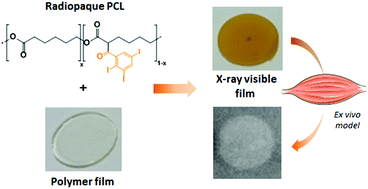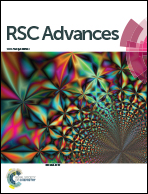Radiopaque poly(ε-caprolactone) as additive for X-ray imaging of temporary implantable medical devices†
Abstract
Implantable polymeric medical devices suffer from a lack of visibility under current clinical imaging techniques. To circumvent this problem, poly(ε-caprolactone-co-α-triiodobenzoate-ε-caprolactone)s (PCL-TIB) containing from 3.5% to 24% of triiodobenzoate-ε-caprolactone units were synthesized as new X-ray macromolecular contrast agents. Physico-chemical and thermal properties of PCL-TIBs were evaluated by 1H NMR, SEC, DSC and TGA. Their potential as radio-opacifying additive for medical devices was evaluated by preparing polymeric blends of PCL-TIB with various (co)polyesters. At first, in vitro X-ray visibility of PCL/PCL-TIB blends was evaluated. A more in depth characterization was then carried out based on PCL/PLA50-PEG-PLA50 blends. The impact of PCL-TIB content on the mechanical properties of blends was evaluated by tensile tests. Stability of X-ray visibility was evaluated by ex vivo implantation of non-degraded blends and of blends degraded for 6 weeks in vitro. Finally, cytocompatibility was assessed by evaluating the proliferation of L929 fibroblasts on the blends.


 Please wait while we load your content...
Please wait while we load your content...